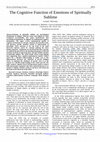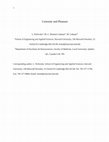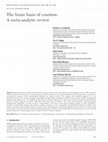Papers by Leonid Perlovsky

The talk discusses a mathematical theory for cognitive engineering, which significantly improves ... more The talk discusses a mathematical theory for cognitive engineering, which significantly improves solutions of many engineering problems and at the same time models spiritual feelings in the human brain-mind. This convergence of scientific, engineering, and religious theories indicates a possibility of signal developments. C. Jung wrote that schism between science and religion points to a psychosis of contemporary collective psyche; survival of culture demands repairing of this schism. Many outstanding scientists are trying to mend this schism. Many books are written arguing that the newest scientific discoveries in molecular biology, evolution, and cosmology do not contradict the main tenets of the world's religions. But there is no scientific theory, explaining spiritual dimension of the mindbrain. "Every one who is seriously involved in the pursuit of science becomes convinced that a spirit is manifest in the laws of the Universe." This Einsteinian statement remains ...

The view presented here is that visual object recognition is the product of interaction between p... more The view presented here is that visual object recognition is the product of interaction between perception and cognition, a process budding from memories of past events. Our brain is proactive, in that it is continuously aiming to predict how the future will unfold, and this inherent ability allows us to function optimally in our environment. Our memory serves as a database from which we can form analogies from our past experiences, and apply them to the current moment. We are able to recognize an object through top-down and bottom-up processing pathways, which integrate to facilitate successful and timely object recognition. Specifically, it is argued that when we encounter an object our brain asks "what is this like" and therefore draws on years of experience, stored in memory, to generate predictions that directly facilitate perception. These feed-forward and feedback systems tune our perceptive and cognitive faculties based on a number of factors: predictive astuteness, context, personal relevance of the given event, and the degree to which its potential rarity differs from our original expectations. We discuss both computational and theoretical models of object recognition, and review evidence to support the theory that we do not merely process incoming information serially, and that during our attempts to interpret the world around us, perception relies on existing knowledge as much as it does on incoming information.

The 2011 International Joint Conference on Neural Networks, 2011
ABSTRACT Functions of conceptual cognition, emotions, language, and music in creativity and think... more ABSTRACT Functions of conceptual cognition, emotions, language, and music in creativity and thinking are analyzed. Much of interactions between these abilities and functions are unconscious. Consciousness keeps us under illusion of continuous conscious presence in the world, in which we mostly understand causes and consequences in everyday life. Only scientific analysis could reveal most fundamental aspects of self. The paper analyses several mechanisms of the mind, which suggest that thinking is not always as autonomous and thoughtful as might be felt subjectively. A significant part of thinking processes might run on autopilot guided by language without much cognition. Creative roles of emotions are considered. Mathematical models and cognitive experiments are analyzed and experimentally verifiable hypotheses formulated.

Studies in Computational Intelligence, 2011
Mathematical and neural mechanisms of concepts, emotions, instincts, imaginations, intuitions are... more Mathematical and neural mechanisms of concepts, emotions, instincts, imaginations, intuitions are described. The paper reviews past mathematical difficulties of modeling the mind and a new mathematical theory of dynamic logic (DL) and neural modeling fields (NMF), which overcome these difficulties. DL evolves fuzzy logic into crisp one. Orders of magnitude improvement is achieved in recognition, fusion, predictions. NMF-DL is extended to a hierarchical mind system, to language and interaction of language and cognition. It follows that language, symbolic abilities, and higher cognitive functions could only evolve jointly. Models of neural mechanisms are developed for the mind hierarchy; they explain roles of the beautiful, music, sublime in the mind, cognition, and evolution of languages and cultures. DL is related to the knowledge instinct, a mechanism that drives the mind to understand the world. This instinct is more important than sex or food. Two mechanisms of the knowledge instinct, differentiation and synthesis, determine evolution of consciousness and cultures, and explain three types of cultural evolutions. The knowledge-acquiring cultures lead to science and technology, but doubt their values; traditional cultures invest limited amount of knowledge with strong emotions, values are certain but knowledge stagnates; multi-cultural societies combine knowledge and values. Different languages lead to different emotionalities and different evolutionary paths of cultures. Differences in emotional mechanisms of languages lead to different paths of cultural evolution and affect cultures no less than lexical contents.
Physics of life reviews, 2010
Applied Mathematics and Computation, 2014
ABSTRACT Cognitive processing by intelligent systems involves the deletion of information in favo... more ABSTRACT Cognitive processing by intelligent systems involves the deletion of information in favor of higher level abstractions. This process can be addressed through the physics of computation but a formal model that explains this process has not been proposed yet. In this short paper, we propose a model that through physical constraints only generates optimal solution to the collapse of n objects into n sets. A numerical simulation of the model results in a logarithmic function of information loss and condensation that perfectly fits our knowledge of cognitive processes.

The 2010 International Joint Conference on Neural Networks (IJCNN), 2010
Heuristic decision making received wide attention due to the work of and inspired multiple studie... more Heuristic decision making received wide attention due to the work of and inspired multiple studies of irrationality of the human mind and a fundamental disregard for knowledge. But what is the source of all human knowledge, including heuristics? We discuss the hypothesis that acquisition of knowledge is a deeply rooted psychological need, a motivational mechanism for perception as well as higher cognition. We report experimental results showing that acquisition of knowledge is emotionally pleasing. The satisfaction of curiosity through acquiring knowledge brings pleasure. This confirms the hypothesis that curiosity or need for knowledge is a fundamental and ancient motivation on a par with other basic needs, such as sex or food. This paper connects curiosity, knowledge, cognition, emotions, including aesthetic emotions of the beautiful, mechanisms of drives, high cognitive functions, minimization of cognitive effort through heuristics, and knowledge maximization. We anticipate our finding to be an important aspect for several classical fields including cognitive dissonance, personality, self, learning, and new directions in cognitive science studying emotions related to acquiring knowledge, personality types in relation to types of knowledge, relating higher cognitive abilities to knowledge-related emotions, and new directions in aesthetics revealing the cognitive nature of the beautiful and music.
Physics of Life Reviews, 2012
Leonardo, 2008
Is it not strange that sheep"s guts should hale souls out of men"s bodies?"

Behavioral and Brain Sciences, 2012
Researchers have wondered how the brain creates emotions since the early days of psychological sc... more Researchers have wondered how the brain creates emotions since the early days of psychological science. With a surge of studies in affective neuroscience in recent decades, scientists are poised to answer this question. In this target article, we present a meta-analytic summary of the neuroimaging literature on human emotion. We compare the locationist approach (i.e., the hypothesis that discrete emotion categories consistently and specifically correspond to distinct brain regions) with the psychological constructionist approach (i.e., the hypothesis that discrete emotion categories are constructed of more general brain networks not specific to those categories) to better understand the brain basis of emotion. We review both locationist and psychological constructionist hypotheses of brain-emotion correspondence and report meta-analytic findings bearing on these hypotheses. Overall, we found little evidence that discrete emotion categories can be consistently and specifically localized to distinct brain regions. Instead, we found evidence that is consistent with a psychological constructionist approach to the mind: A set of interacting brain regions commonly involved in basic psychological operations of both an emotional and non-emotional nature are active during emotion experience and perception across a range of discrete emotion categories.
Pattern Recognition Letters, Jul 1, 1988
Cramer Rao bounds for the estimation of means in a multiclass clustering problem are derived unde... more Cramer Rao bounds for the estimation of means in a multiclass clustering problem are derived under the assumption that each class has a normal probability distribution. These Cramer-Rao bounds are ellipsoids as in familiar single class problem; however, their shape and size depend on the geometry of the overlap between classes.
2007 International Joint Conference on Neural Networks, 2007
The knowledge instinct drives higher cognitive functions of the mind and determines evolution of ... more The knowledge instinct drives higher cognitive functions of the mind and determines evolution of consciousness and cultures. Neural modeling fields mathematically describe these mechanisms, including concepts, emotions, instincts, consciousness and unconscious. The two main aspects of the knowledge instinct are differentiation and synthesis. They are in complex relationship of symbiosis and opposition, leading to complex non-linear evolution. Mathematical modeling of these dynamics in a population leads to predictions for the evolution of languages, consciousness, and cultures.
Standard Form 298 (Rev. 8/98) REPORT DOCUMENTATION PAGE Prescribed by ANSI Std. Z39.18 Form Appro... more Standard Form 298 (Rev. 8/98) REPORT DOCUMENTATION PAGE Prescribed by ANSI Std. Z39.18 Form Approved OMB No. 0704-0188
Ieee Transactions on Neural Networks, Jul 1, 2008
Dynamic aspects of higher cognitive functions are addressed. Dynamical neural networks with encod... more Dynamic aspects of higher cognitive functions are addressed. Dynamical neural networks with encoding in limit cycle and nonconvergent attractors have gained increasing popularity in the past decade. Experimental evidence in humans and other mammalians indicates that complex neurodynamics is crucial for the emergence of higher-level intelligence and consciousness. We give an overview of research activities in the field, including dynamic models of consciousness, experiments to identify neurodynamic correlates of cognitive functions, interpretation of experimental findings, development of dynamical neural memories, and applications of dynamical approaches to intelligent system.
International Journal of Psychology and Behavioral Sciences, 2012







Uploads
Papers by Leonid Perlovsky